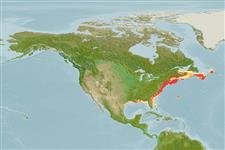>
Syngnathiformes (Pipefishes and seahorses) >
Syngnathidae (Pipefishes and seahorses) > Syngnathinae
Etymology: Syngnathus: Greek, syn, symphysis = grown together + Greek, gnathos = jaw (Ref. 45335).
Environment: milieu / climate zone / depth range / distribution range
Ekologi
marina; sötvatten; brackvatten bottenlevande; amfidrom; djupintervall 5 - 49 m (Ref. 126547). Subtropical; 50°N - 26°N
Western Atlantic: Gulf of St. Lawrence in Canada to northeastern Florida in USA; also in northwestern Gulf of Mexico.
Size / Vikt / Age
Maturity: Lm ? range ? - ? cm
Max length : 33.0 cm TL hane/ej könsbestämd; (Ref. 6330); common length : 17.0 cm TL hane/ej könsbestämd; (Ref. 6330)
Inhabits seagrass beds in bays and estuaries, but also enters fresh water (Ref. 7251). Resident in estuaries during spring through fall, migrates into near shore continental shelf waters during winter. Found in waters of 4-17 °C. Ovoviviparous (Ref. 205). The male carries the eggs in a brood pouch which is found under the tail (Ref. 205).
Life cycle and mating behavior
Könsmognad | Reproduktion | Lek | Ägg | Fecundity | Larver
Male carries the eggs in a brood pouch (Ref. 205).
Lazzari, M.A. and K.W. Able, 1990. Northern pipefish, Syngnathus fuscus, occurrences over the Mid-Atlantic Bight continental shelf: evidence of seasonal migration. Environ. Biol. Fishes 27(3):177-185. (Ref. 6330)
IUCN Red List Status (Ref. 130435)
Threat to humans
Harmless
Human uses
Ytterligare information
Age/SizeTillväxtLength-weightLength-lengthLength-frequenciesMorfometriMorfologiLarverLarvdynamikRekryteringAbundansBRUVS
referenserVattenbrukVattenbruksprofilAvelslinjerGenetikElectrophoresesÄrftlighetSjukdomarBehandlingNutrientsMass conversion
Verktyg
Special reports
Download XML
Internet-källor
Estimates based on models
Preferred temperature (Ref.
123201): 0.5 - 20.4, mean 4.9 °C (based on 199 cells).
Phylogenetic diversity index (Ref.
82804): PD
50 = 0.5000 [Uniqueness, from 0.5 = low to 2.0 = high].
Bayesian length-weight: a=0.00028 (0.00012 - 0.00065), b=3.21 (3.03 - 3.39), in cm total length, based on LWR estimates for this Genus-body shape (Ref.
93245).
Trofisk nivå (Ref.
69278): 3.2 ±0.0 se; based on diet studies.
Resiliens (Ref.
120179): Hög, lägsta populationsfördubblingstid mindre än 15 månader (Preliminary K or Fecundity.).
Fishing Vulnerability (Ref.
59153): Low vulnerability (23 of 100).
